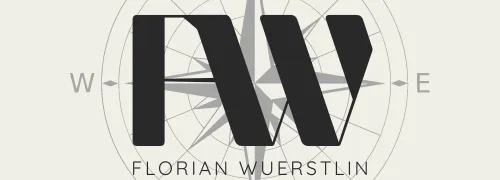Donon Vosges – Hiking on the mountain of the frozen winds
Bonjour,
In this last foray of the year 2024, we visit a special place.
A place of exchange, struggle and mysticism, which I think is a good conclusion to this first year of my blog.
Why are we visiting Donon?
This trip to France to see the sights of the Vosges followed a very atypical start for us.
We looked at the map of Alsace and the surrounding areas and finally came across a lake that, when you see it on the map, looks like a twisted leaf of a tree from above.
This is the Lac de Pierre-Percée.
The lake looked exciting from the very first moment.
Somewhere in the middle of nowhere in France.
It seemed to be hiding something, and not just because of its unusual shape.
So we looked for an AirBNB and one of the providers advertised their accommodation with a picture of the Donon massif and the Temple Mount, among other things.
When we saw this, we knew immediately that we had to go there and that we definitely wanted to visit this point in the Lower Vosges.
The picture of this historic place in France is picturesque in summer at sunset and I think it arouses the curiosity of everyone who sees it.
No sooner said than done.
We looked for suitable accommodation and traveled to this beautiful and inviting region on the cultural border of Alsace-Lorraine.
Where exactly is Donon in Alsace?
The Donon lies at the heart of the Donon massif and forms a natural intersection between three départements in the Grand Est region:
Bas-Rhin (Lower Rhine) in Alsace, as well as Vosges (Vosges) and Meurthe-et-Moselle (Meurthe and Moselle) in Lorraine in eastern France.
This location has always given the mountain a special significance, as it represents a link between the regions.
The Donon was already a hub in ancient times.
It was a Celtic place of worship and the Romans used it as a strategic crossing point and built roads that led over the mountain.
These paths connected the Rhine Valley in the east with the plains of Lorraine in the west. Even today, the mountain marks a geographical and cultural border between Alsace and Lorraine.
The summit location also offers a wide panoramic view over all three départements.
On clear days, the view extends from the Bruche valley to the Lorraine plain.
This makes the Donon not only a popular hiking destination, but also a place of spiritual and strategic importance.
Journey to the mountain in the Vosges
The best way to reach the Donon massif is to drive your car to the Donon parking lot.
There is not only enough storage space for parking.
You will also find a map of the area and sanitary facilities, which makes the parking lot an ideal starting point for the trip.
Before we take you to the mountain and its special impressions and moods, I would like to explain one more thing.
This story I’m telling you today is about the temple in the snow and what I think is its special effect against the backdrop of the snow and ice of the Vosges mountains.
Of course, if you visit at a different time of year, your real impression may be completely different.
Even though I think it will always retain its uniqueness and is always worth the trip.
The first steps on the sacred Mount Donon
From the Col du Donon parking lot past the wooden houses, there are several historic hiking trails that lead up to or around the summit of the Petit Donon.
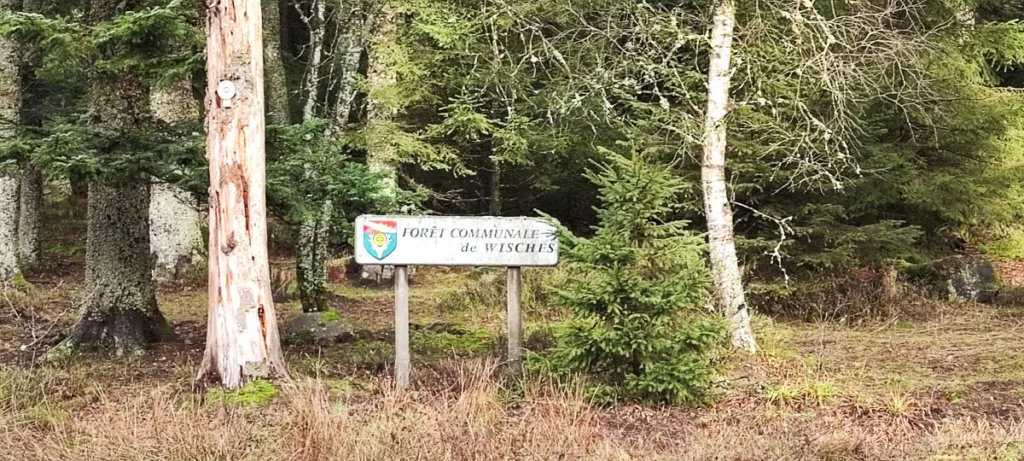
We choose the wide path in the middle, even though it immediately draws our attention with a steep ascent.
The trees and edges of the path are covered in snow and as we take our first steps, the reddish-brown of the loamy ground shimmers out from under the snow.
Right at the start, we are grateful for our good footwear.
The angle is steep, as if this path would lead straight to the top.
So we walk carefully uphill, step by step, as we pass rows of snow-covered conifers in Alsace in winter.
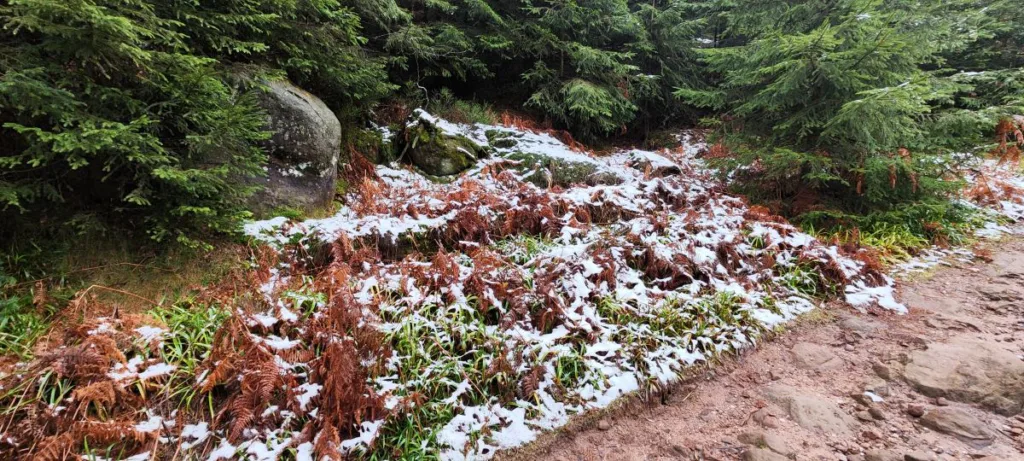
There is a strange natural energy about this place that can be felt from the first few meters down here.
Everything seems quiet, as if the sounds of the world stop before the massif rises.
Even the birds that sometimes fly past us seem to move almost silently.
All you can hear is a rustling sound as they plunge into the treetops.
All you can hear is the rustling of your own boots in the snow and the soft sound of your own breathing.

The higher you get, the clearer and fresher the air becomes.
You have the feeling that this air comes from a distant time before factories and industry, so clear and fresh does it pass through your lungs.
But it is also cool and you notice that it gets cooler with every step up the path through the dense forest.
Even on the first small intermediate plateau, the snow and slush lying around has turned into a closed and frozen blanket of snow, interrupted only by the holes of stomping feet on the forest path.
The half circular route and the witnesses of history
At this major fork, we keep to the right on a path through the dense forest, which promises a lot of relaxation.
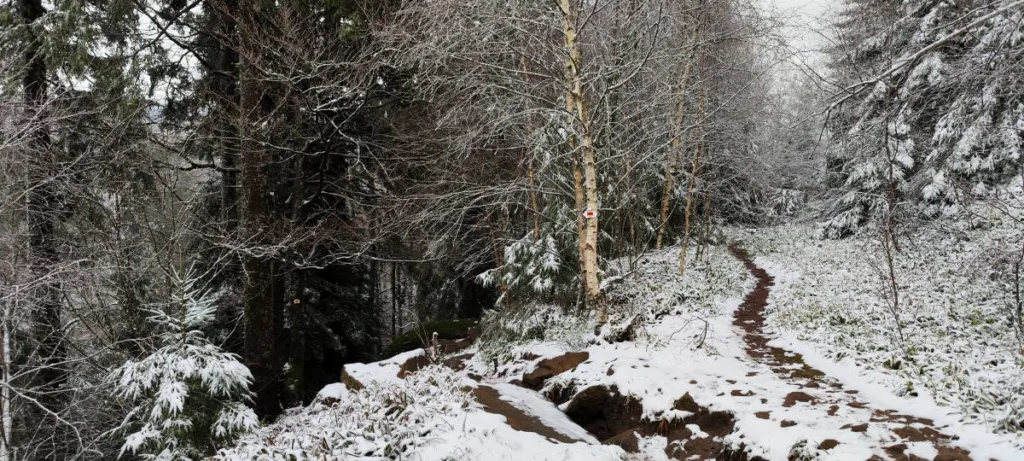
The path is no longer so steep, but flattens out a little and runs straight along the side of the mountain as a forest path.
From time to time, I had slight doubts about how to climb the mountain when it was only flat and straight ahead, but no longer uphill.
But the flat also has its beautiful sides.
You navigate in a slalom between fallen trees and overhanging bushes and even pass tree lines that turn the whole thing into an adventure tour.
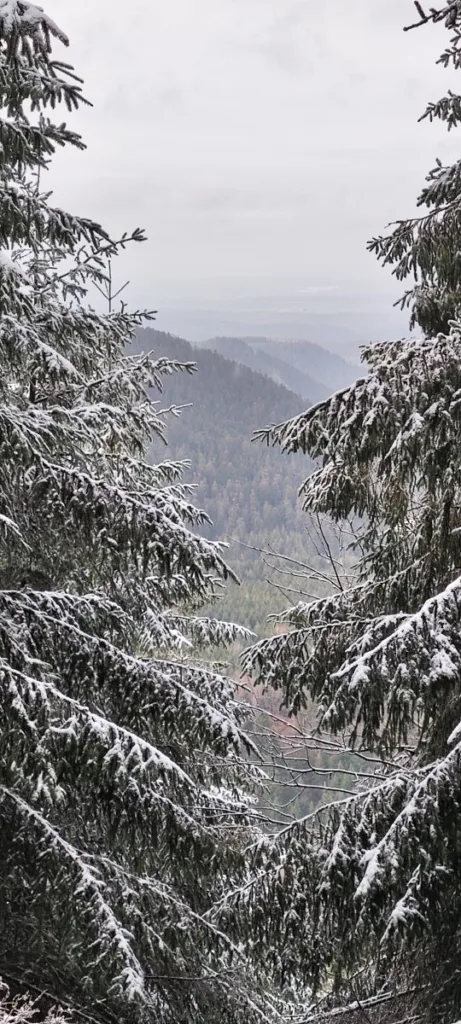
On the way, my mind wanders and I think about the rich history of this place.
In both world wars, this place was the scene of French and German history.
A place of struggle
Germans and French fought over this mountain, its strategic location and the distant view from the summit of the Donon massif.
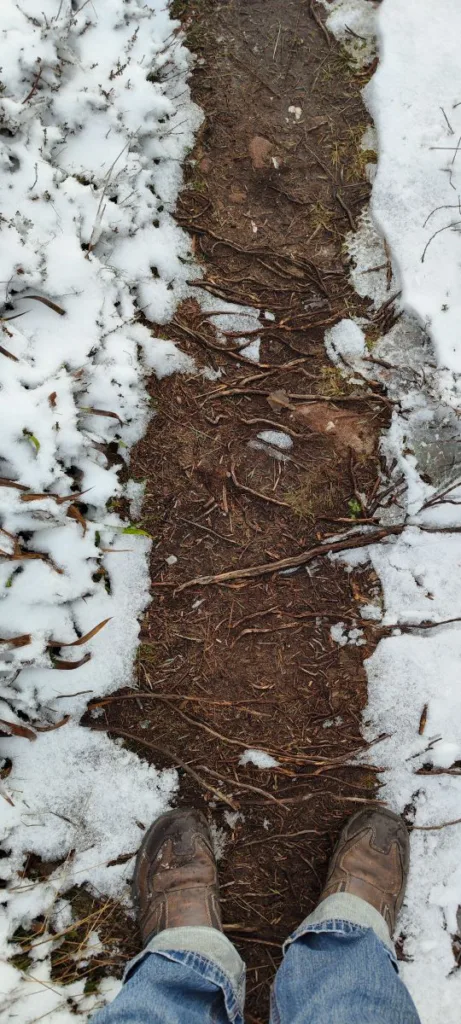
I take myself back to that time for a moment and imagine myself as a soldier lying behind one of the many trees and rocky outcrops, waiting for the next battle.
Or how I hid from the advancing German occupiers as a resistance fighter in the Resistance during the Second World War.
It is hard to believe that battles for life and death took place in this peaceful place, which radiates such serenity and tranquillity and where you feel in harmony with nature.
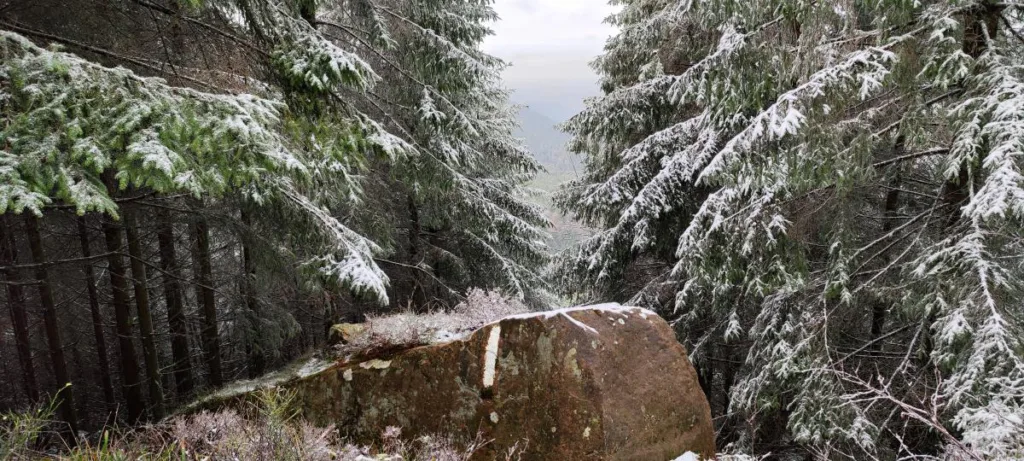
It doesn’t seem to fit in with this place in the slightest, or even belong here.
Because here you have the feeling of moving further away from everyday life and your routines, worries and thoughts with every step upwards.
You will also notice markings and signs throughout the area as you hike.
After the battles of the First World War, the German commander commissioned one of his soldiers, a stonemason, to place these markings on the so-called Path of the Stelae as a memorial to the fallen French and German soldiers.
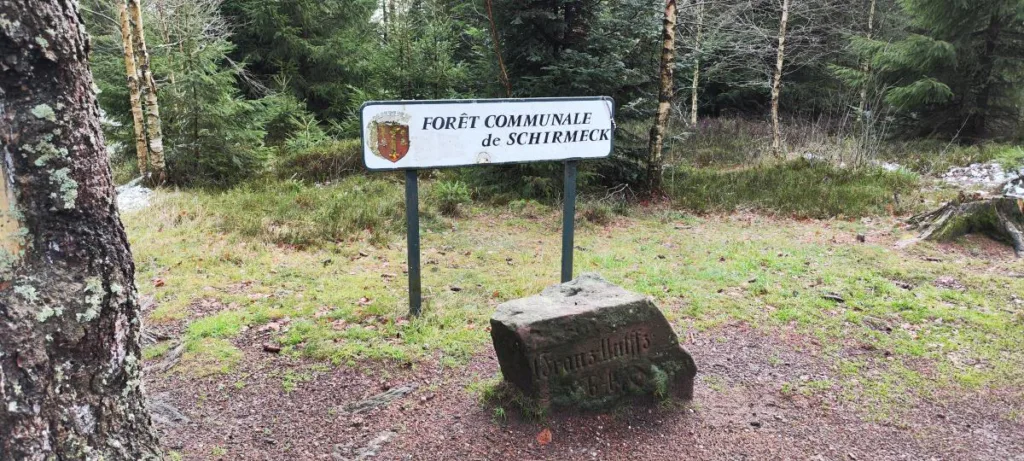
So they are a tribute to the fallen, no matter which banner they followed.
The snow gets deeper with every step and the cold, which slowly creeps into our clothes around our feet, brings us back to reality.
The location of the station and the assembly of the figures
By now we have been walking straight ahead for quite some time, with only a minimal gradient, when the path leads us over a steeper rocky passage onto a large plateau.
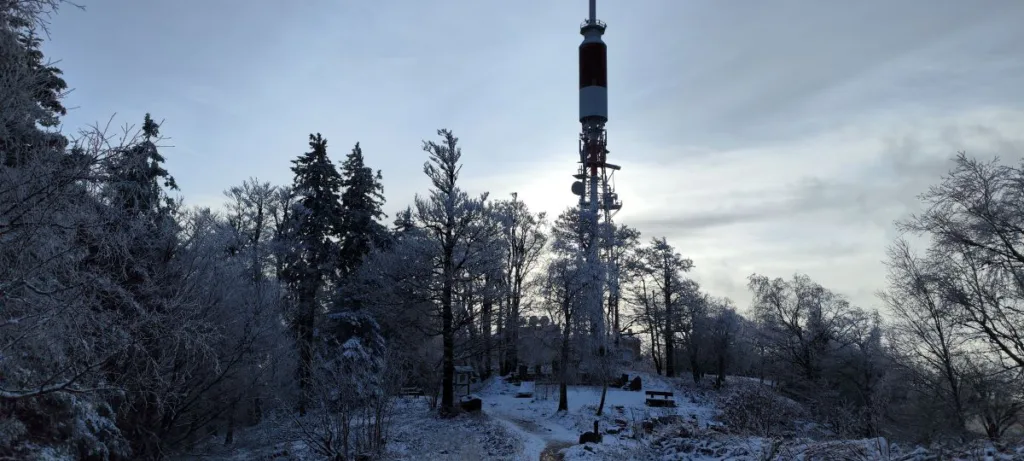
The first thing that immediately catches the eye here is a radio tower and some smaller buildings as well as a circle with stones, which we now draw our attention to.
On the way, we allow ourselves a panoramic view of the plateau, but there is still no sign of the summit itself.
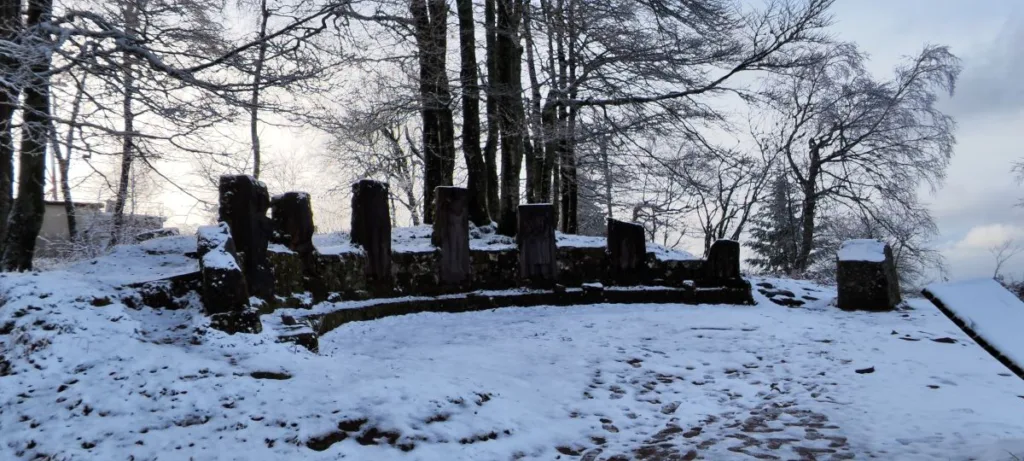
Research has since revealed that the station was part of the American air defense during the Cold War as a radar station, but was decommissioned years ago.
We reach the stones arranged in a row, whose origin and message are not exactly documented.
When I look at the stones, their arrangement and the faces of the figures, I think of a meeting place.
Maybe it was, or maybe it is today.
In my opinion, these portraits bear witness to important events, beautiful celebrations and therefore to life itself.
The Temple Mount of Donon
We turn around and get ready for the last few meters to our destination on the stony path to the Donon and its highest point.
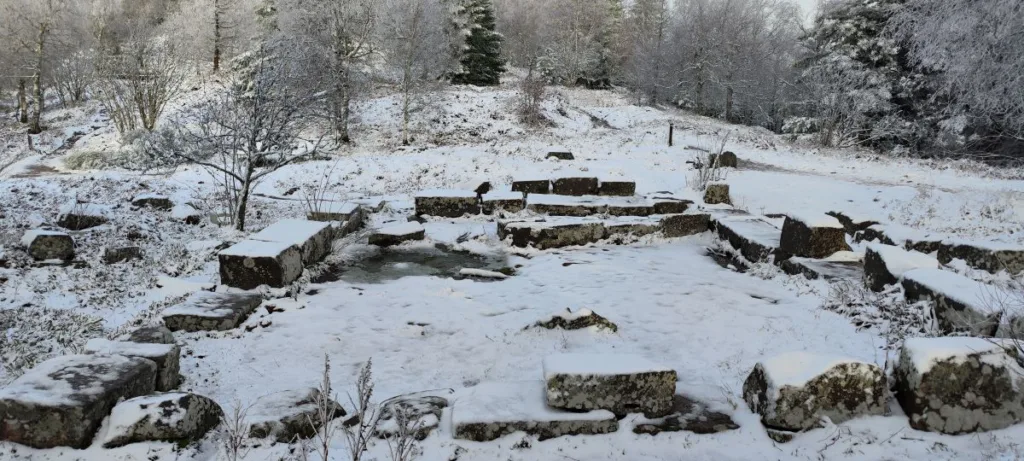
The path is a little harder now, but it’s not far.
Although there are steps, they are long and high in places, making the ascent an effort that should be approached with caution.
The path leads us sideways in a loop along the mountain, so that we are above our last path and get our first impressions of the view of the surrounding green and densely wooded mountains of the provinces of Alsace and Lorraine.
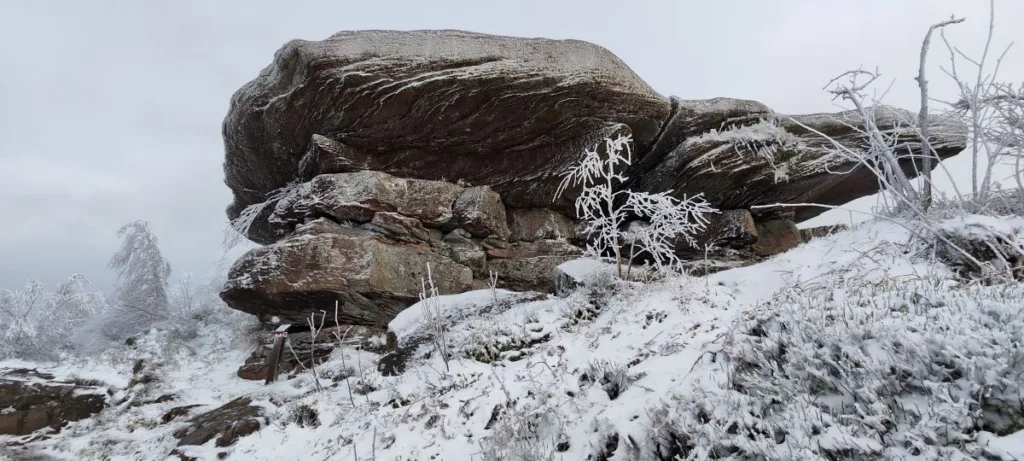
The pace slows further as the path, which now looks more like a path, becomes increasingly narrow and steep.
But if we then turn up to the right, the dark stone of the building on the summit of the Donon appears above us on the right.
We overcome the last few meters and stand on the plateau of the temple, which rises up to the horizon to our right, as if it should demand the important view in exactly this direction.
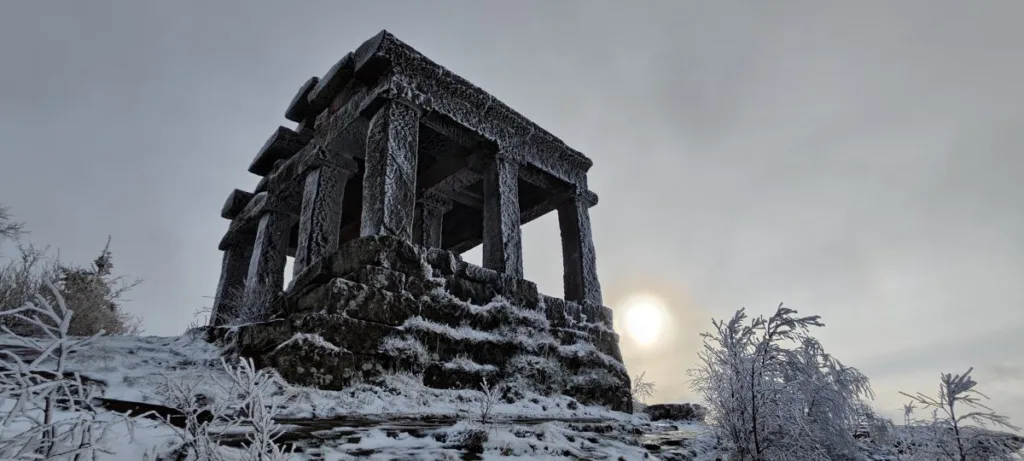
The plateau is large and almost flat on both sides.
A path runs from the Donon temple to the other side, the edges of the plateau densely overgrown with fir trees and other conifers.
However, the impression of the entire area is immediately dominated by the temple, which we turn towards on the right.
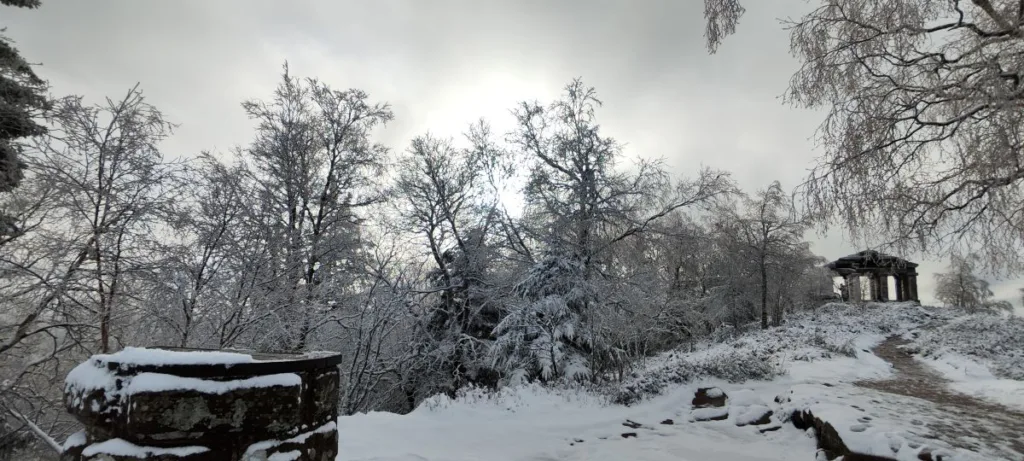
It stands square, in the pale light of the sun, surrounded by snow at an altitude of 1009 meters.
The stone looks gray-black, but even the darkness of its exterior creates a sparkle through the ice that covers it, making it look to me as if it had grown directly from the stone of the mountain.
My impressions and thoughts on the Temple of Donon
I hesitate for a moment and imagine myself back in the history of this place.
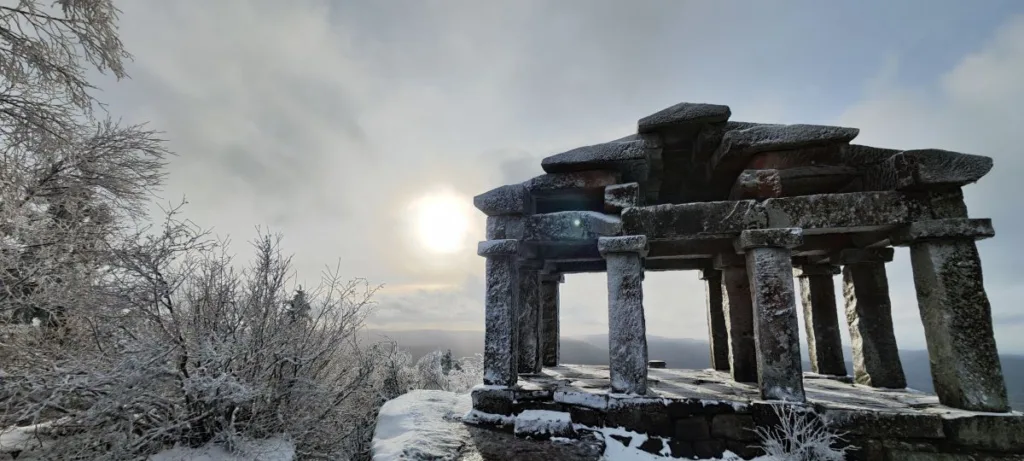
According to archaeological studies, it was the site of an early Celtic cult before the Romans erected a new Gallo-Roman temple to the god Mercury here.
It lost its significance with Christianization and fell into disrepair over time.
Until it was rebuilt in its current form in 1869 during the Second French Empire as part of Napoleon III’s architecture. Intended as a symbol of culture and history.
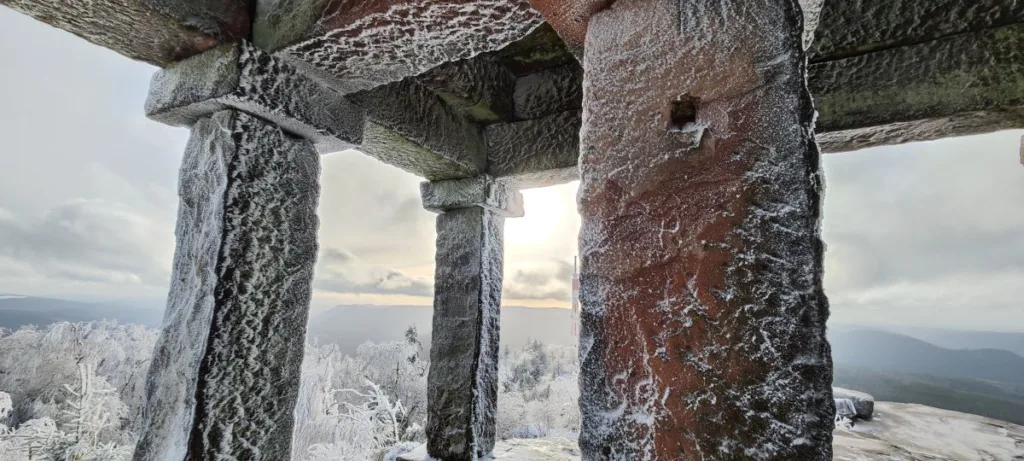
Yes, a symbol. And yet it is so much more.
I can understand why a temple and meeting place was built in this place despite its difficult accessibility.
He is special.
You can feel this just by looking around, with the fantastic view in all directions as far as the distant valleys over the dense forests of the neighboring mountains.
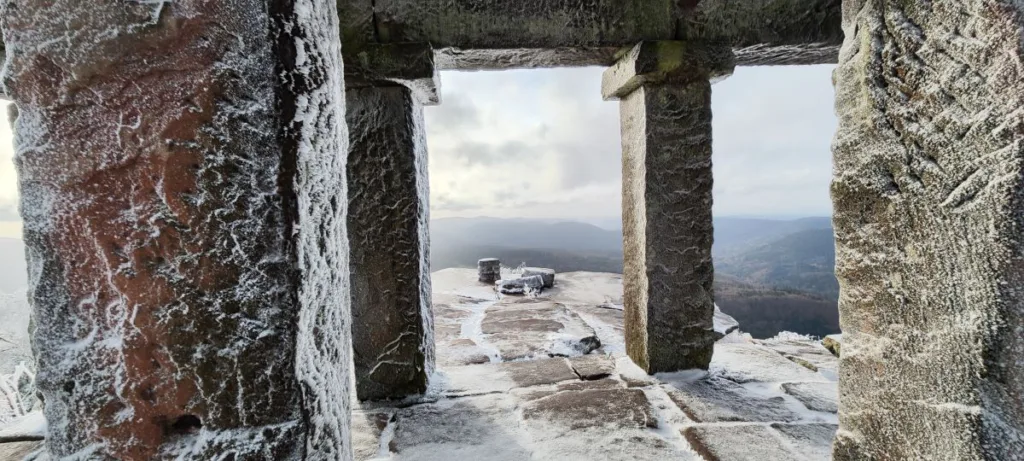
When you listen to the wind and breathe in the fresh, clear air.
I deliberately chose the title of this article because it describes how you feel here.
Now in winter, the whole area seems frozen, as if time stands still here.
As if this place were an oasis of peace in time.
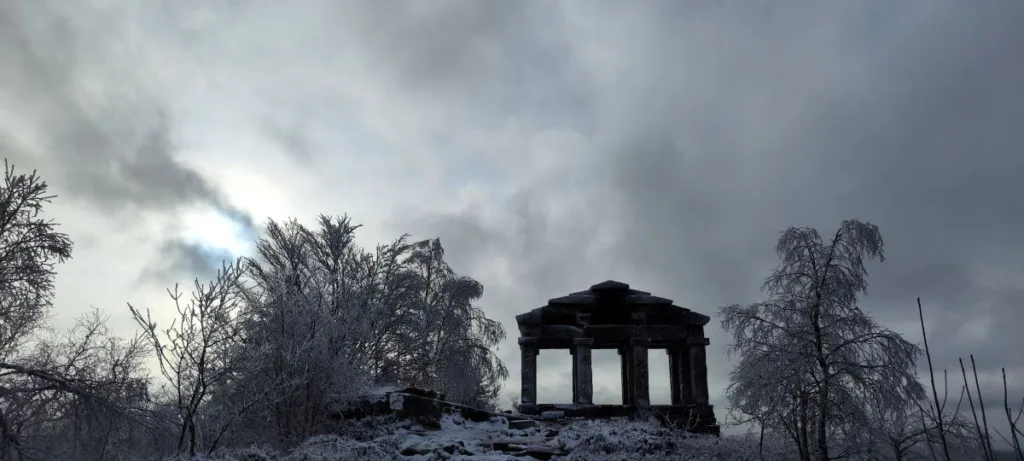
Far away from all routines, stress and the fast pace of life.
If you are looking for a place that takes you away from your life and keeps you in a moment where you can just enjoy, breathe and find yourself, Donon is perfect for you.
I took several of these moments during my stay.
In some I thought about various things in my life, in others I thought nothing at all and just enjoyed myself.
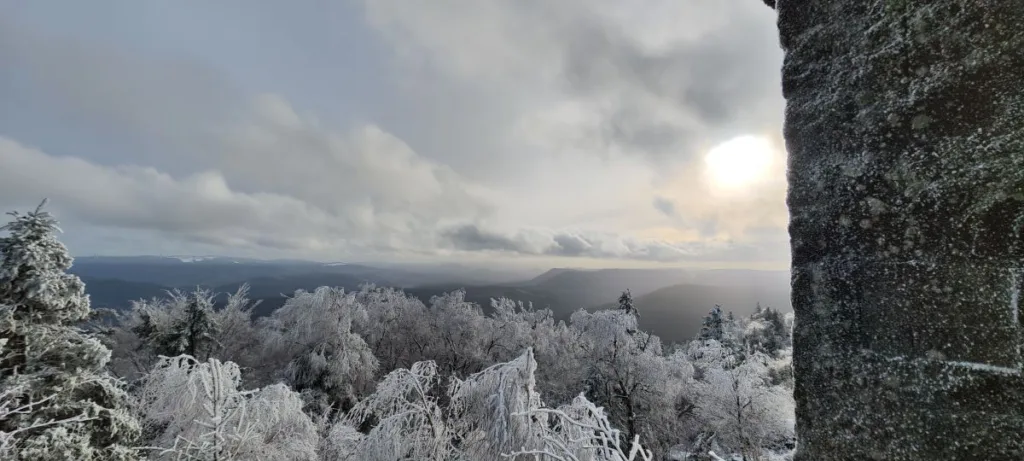
This place was perfect for me to enjoy the peace and quiet of winter.
The Romans dedicated this place to the god Mercury, and it is of course “only” an imitation of an ancient temple.
But that didn’t matter to me, because its special impression and also its significance are preserved for me by this symbol, which is already over 150 years old, in the replica.
The summit plateau of Donon
The temple is completely accessible and also creates a picturesque atmosphere with its architectural style and the many interesting views in all directions.
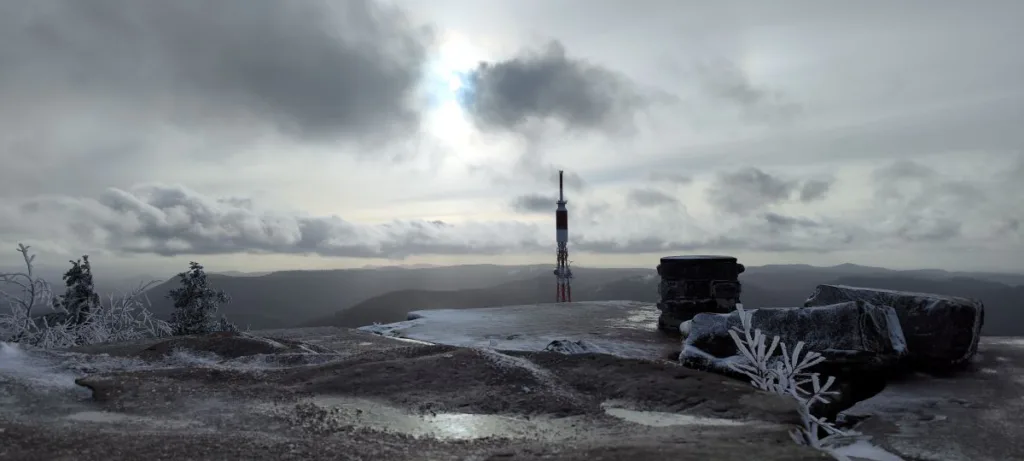
On the front, I had to be careful again, as the areas were completely iced over.
But the view to the right down to the Col entre les deux Donon is well worth the effort.
In general, I would ask you to be careful if you want to visit Donon on the border of the Alsace and Lorraine cultures in winter, as I did.
The place is not cleared or gritted, which is perfect for the atmosphere.
But you should be careful where you step.
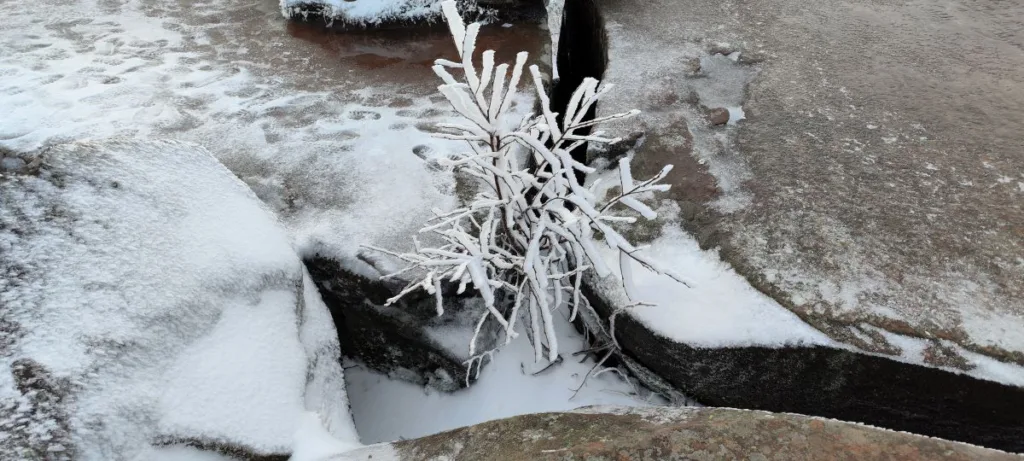
As you step past the temple to another viewpoint and onto the other side of the rocky plateau, deeper and deeper furrows appear in the ground, leading into deep trenches.
Here, too, we see traces of the battles of the world wars around this strategically important point in the east of France.
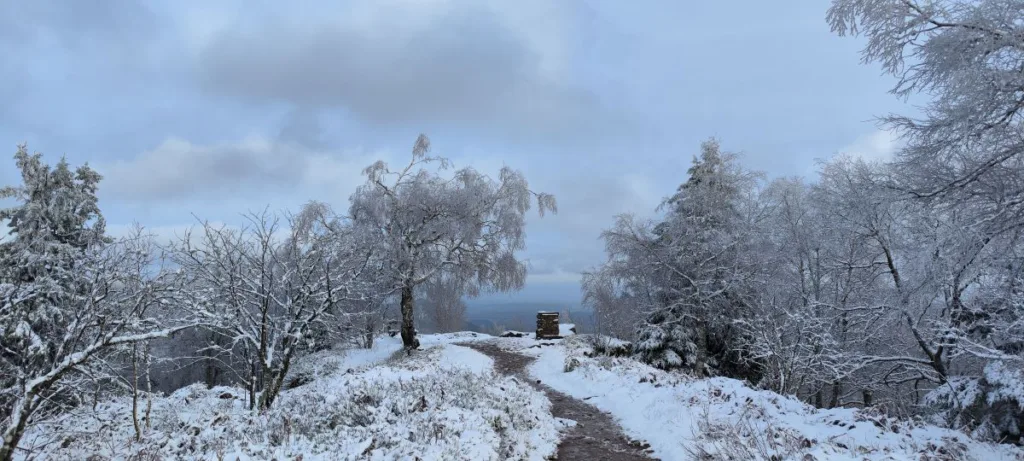
Alongside many other silent witnesses to the conflicts of the past, these may also serve as a memorial for a better future.
But from this point in the Northern Vosges, you can see the Rhine plain and other Massif des Vosges mountains on a clear day.
Thank you for your reading and thoughtful accompaniment on our winter walk up the sacred mountain of Petit Donon.
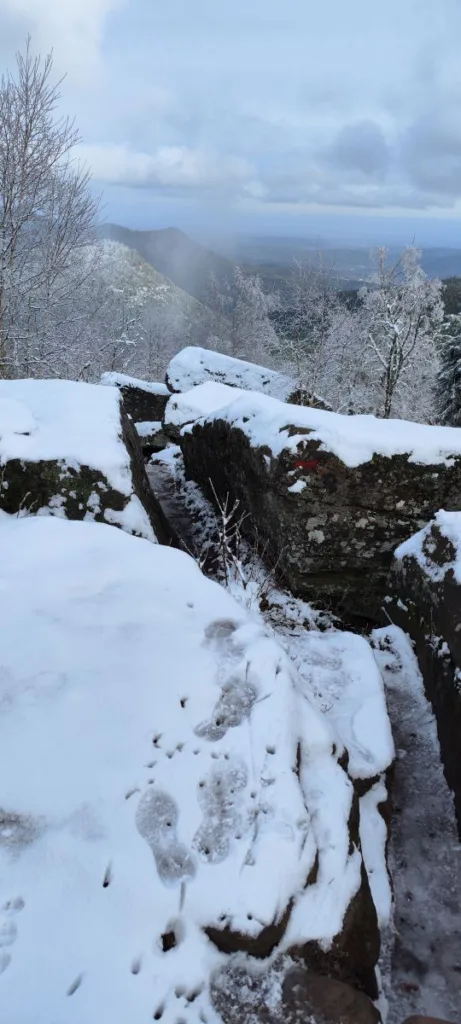
The winter hike on the “Chemin et Col entre les deux Donons” was an interesting and exciting experience.
Pleasant travel and many discoveries
wishes you
Florian
Look around and follow me
My social media presence, my ebook and interesting facts about me

References
(1) https://www.my-weekend-in-alsace.com/
(2) https://www.tourisme-alsace.com/
(3) https://www.histoire-france.com/
(4) https://www.vosges-nature.com/
(5) https://park4night.com/
